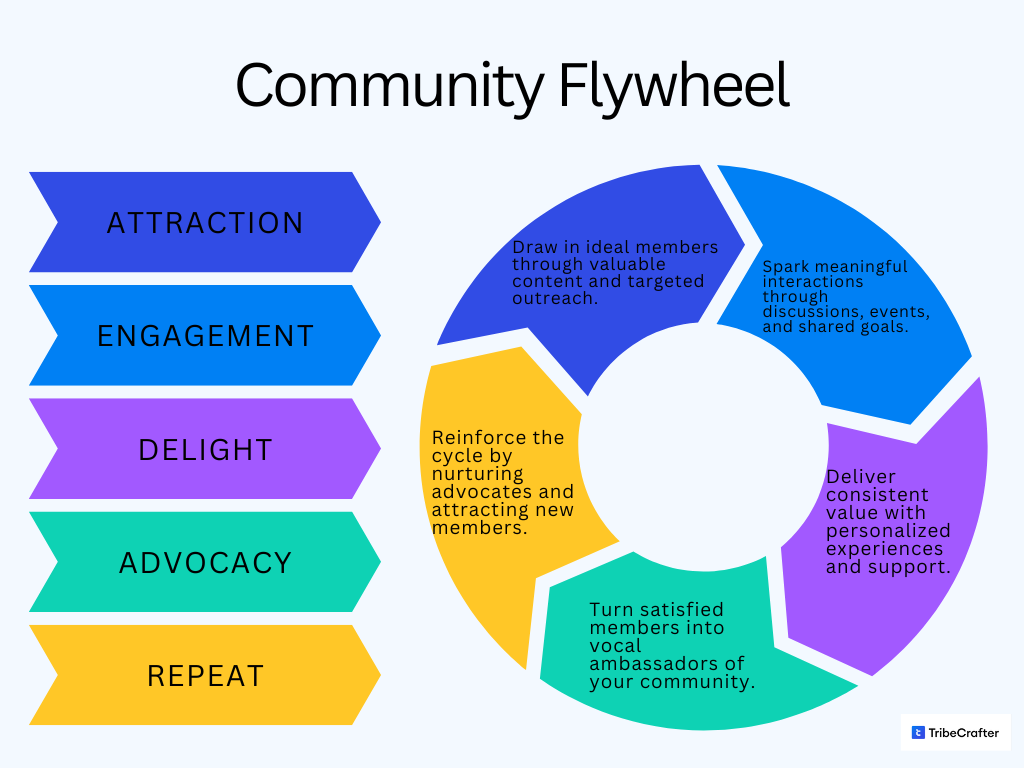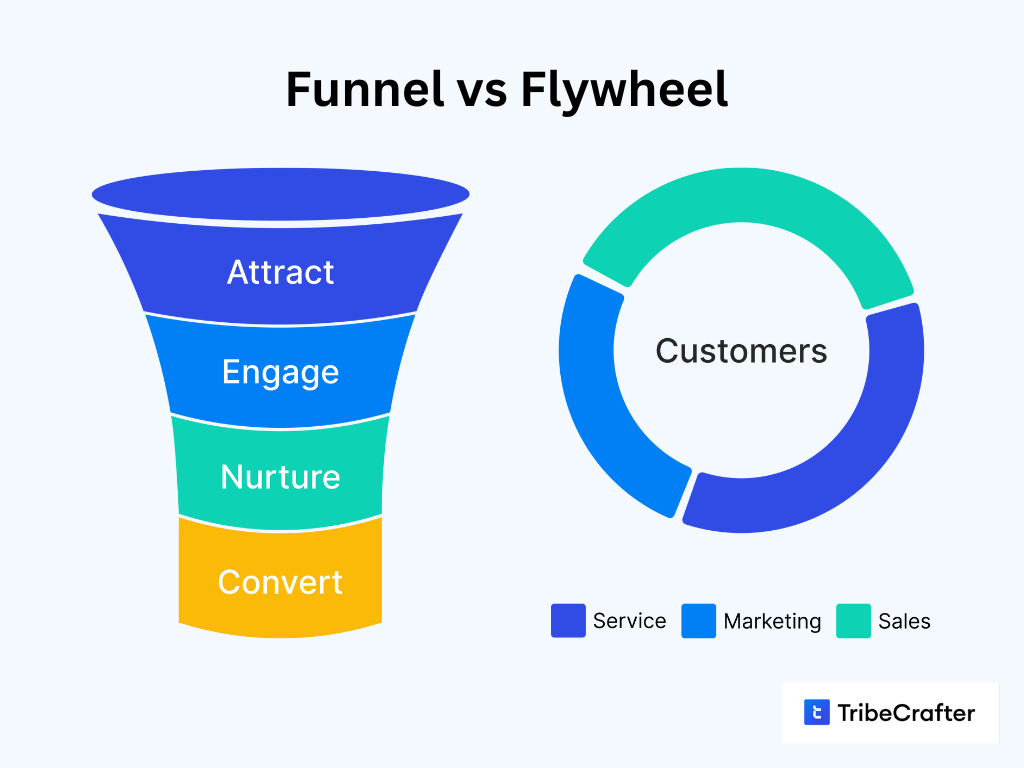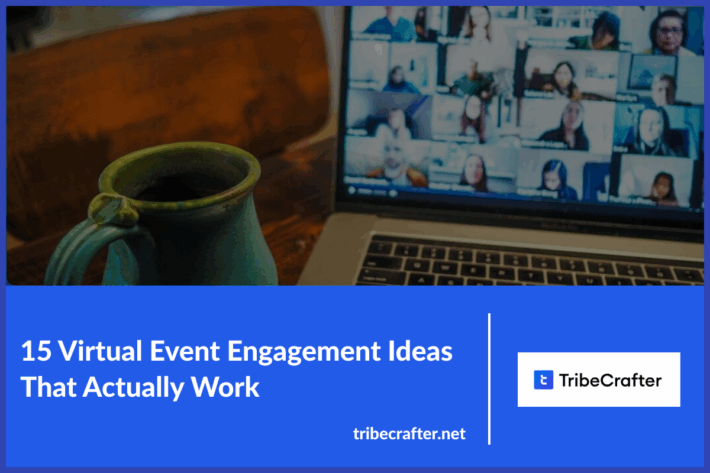Community Flywheel: The Growth Engine for Brands & Creators
Table of Contents
What is a Community Flywheel?
Creating an online community for your business is a smooth and painless process but keeping the community engaged is something that needs your real effort.
This is where the concept of community flywheel comes into action. A community flywheel is a dynamic, community-driven growth framework that helps your brand scale through engagement, user-generated content, and brand advocacy.
In simple words, a community flywheel model is a self-sustaining loop that helps your online community grow and stay active — without needing constant effort from you.
When a brand develops a community experience — whether on social media or its own platform—that generates high engagement, pleasant experiences, and readily converts into sales, it’s known as a community flywheel.
Components of community flywheel
As discussed earlier, the community flywheel is a self-sustaining growth loop that helps your business to scale. Making the correct decisions early on and determining the ideal community-market fit creates momentum that not only helps the brand community expand but also ensures that this growth continues over time.

A community flywheel has following components:
Attraction
Creating an atmosphere where people feel included and encouraged to engage is crucial, whether it’s an online forum, a consumer community, or an employee network.
To kickstart your community flywheel, focus on attracting your ideal members — the ones most aligned with your brand or product. Leverage user-generated content that not only delivers real value but also directly addresses your audience’s needs and interests.
The goal should be to create a community or platform that encourages open communication and collaboration.
Engagement
As soon as people join the community, they start to get involved. This suggests that people take part in things like buying products, giving valuable feedback, or talking about their experiences.
The ability of the community flywheel to accelerate through consistent engagement is its real strength. The flywheel accelerates when community members actively engage, exchange ideas, and add to conversations.
Interactive tools can also be used to strengthen the bond between the brand and its community members. Here are some examples of interactive marketing tools that can strengthen community engagement and loyalty:
1. Polls & Surveys
- Tools: Typeform, Google Forms, Polls in Discord/Facebook/Slack
- Why it works: Gives members a voice, helps you gather feedback, and makes them feel involved.
2. Quizzes & Assessments
- Tools: Outgrow, Interact, Thrive Quiz Builder
- Why it works: Fun and shareable; helps users discover personalized results and creates value.
3. Live Q&A Sessions / AMAs
- Tools: Zoom, YouTube Live, Instagram Live, Twitter Spaces
- Why it works: Builds authenticity and trust; lets members interact directly with your brand or founder.
4. Interactive Webinars & Workshops
- Tools: WebinarJam, Hopin, Crowdcast
- Why it works: High-value sessions that also allow chat, polls, and real-time collaboration.
5. Gamification Features
- Tools: TribeCrafter, Leaderboards, XP systems
- Why it works: Rewards participation, sparks friendly competition, and keeps members coming back.
6. User-Generated Content Campaigns
- Tools: Hashtag challenges (Instagram, TikTok), UGC contests, Story templates
- Why it works: Makes members feel seen and celebrated, and provides content you can reshare.
7. Community Challenges
- Tools: Dedicated forum threads, Notion/Google Docs trackers, in-app systems
- Why it works: Encourages group participation and gives a shared goal (fitness, learning, etc.).
Delight
This is a very crucial phase in a community flywheel on which the whole success of flywheel depends.
On desktop and mobile devices, customers anticipate a seamless, speedy transaction experience. However, a lot of retailers fall short in this phase, which results in lost sales and high cart abandonment rates. Expectations for a seamless experience are further raised by new online buying platforms like social commerce.
Advocacy
Find out which of your consumers are satisfied with your product, active, and willing to help other members or provide referrals. To strengthen your brand and draw in new clients, include them in your advocacy program and use the network.
The cycle is now complete, and it is clear that every touchpoint can be integrated with the community.
Benefits of a Community Flywheel for Brands & Businesses
By adopting the community flywheel model, businesses can drive sustainable growth through consistent engagement, user participation, and community-led momentum.
Unlike traditional one-way marketing funnels, the flywheel relies on a continuous loop of value creation — where each interaction adds energy to the system.
As members contribute content, support one another, and advocate for the brand, the community becomes a powerful growth engine. This not only reduces dependency on paid acquisition but also builds long-term loyalty, increases customer lifetime value (LTV), and lowers churn.
Over time, the flywheel compounds, making growth more efficient and scalable with each cycle.
Community Flywheel vs Traditional Growth Models
Traditional marketing has long relied on the funnel model — a step-by-step process where potential customers are guided from awareness to conversion. But in today’s community-first era, the flywheel model is proving far more effective for building lasting growth and deeper customer relationships.

The Funnel: Linear and Conversion-Focused
The marketing funnel follows a linear path:
Attract → Engage → Capture → Nurture → Convert
- The goal is simple: move prospects toward a sale.
- Once someone becomes a customer, they drop out of the funnel.
- It’s business-driven, not customer-centric.
- There’s little focus on what happens after the conversion.
This approach often leads to high acquisition costs and misses the opportunity to build loyalty or leverage word-of-mouth growth.
The Flywheel: Circular and Customer-Centric
In contrast, the flywheel puts customers at the center, and is powered by three key forces:
Marketing → Sales → Service
All working together to create momentum.
- Happy customers become advocates.
- Referrals, user-generated content, and community engagement keep the flywheel spinning.
- The cycle is continuous — not just a one-time push.
The more value you provide, the more energy the flywheel builds, making your growth self-sustaining and scalable.
How to Build Your Own Community Flywheel
If you’re a solopreneur, creator, or brand builder, you don’t just want an audience — you want a community. One that engages, grows organically, and brings others with them. That’s where the community flywheel comes in.
Unlike a traditional funnel, a flywheel gains momentum the more you feed it. It becomes a self-sustaining growth engine. Here’s how to build yours — in a way that’s actually doable, even if you’re a team of one.
1. Define Your Community’s Purpose
Before you start building, you need to know why people would gather around you. What’s the shared goal, passion, or struggle that connects your future members?
2. Get Crystal Clear on Your Niche
The tighter your niche early on, the faster your flywheel spins. Think beyond demographics — focus on goals, values, and struggles.
3. Create a Strong Entry Point
Don’t just ask people to “join your group.” Give them a reason to show up. Launch a free resource, host a challenge, or share a tool that solves a specific pain point.
4. Choose Your Platform Wisely
Pick a platform that fits how your people communicate. Are they casual? Slack or Discord. More professional? Circle or LinkedIn. Broad and open? Facebook Groups.
5. Start with 10 True Fans
You don’t need hundreds of members. You need 10 engaged ones who care. DM them personally. Make them feel like insiders. Ask for their input. Let them co-create the culture.
6. Build a Simple Content Rhythm
Communities thrive on consistency. Create rituals, not just random posts. Think weekly check-ins, live sessions, tip drops, or “win of the week” shoutouts.
7. Recognize and Elevate Members
People come for the content, but they stay for the recognition. Highlight contributions. Give shoutouts. Create paths for members to take on roles or host sessions.
8. Make It Easy to Invite Others
Give members tools to spread the word — referral links, graphics, or copy-paste messages. The easier you make it to share, the faster your flywheel turns.
9. Automate the Welcome Experience
Don’t let new members feel lost. Automate a warm, clear onboarding. Give them three simple actions to take immediately.
10. Review, Refine, Repeat
Every month, step back. What’s driving the most engagement? Which members are most active? What content leads to the most invites or shares?
Real-Life Examples
When you can observe measurable outcomes, it becomes simpler to appreciate the benefits of community-powered growth. Communities have been used by a number of big brands to expand.
Notion
Since Notion is joining a competitive market for productivity and organizing tools, its success in creating online communities is astounding. One of the main factors contributing to the community’s success is the wide range of interaction opportunities it offers.
Both official and informal community alternatives are part of the Notion approach to the community. As of November 2022, there are dozens of Notion-certified consultants available for ardent lovers to become. The business also offers a campus program and ambassador program where fans can congregate.
Figma
One well-known example of a business that has effectively adopted a community-led growth strategy is Figma, which has used the community and collaborative nature of its product to propel notable growth. Building a strong user base will enable them to interact with the product, exchange resources, and promote its use, which will eventually increase the number of users and brand recognition.
Duolingo
The most widely used language-learning website in the world, Duolingo, has amassed a fortune thanks to its community-led growth approach. With more than 500 million users and free courses available in more than 40 languages, this forward-thinking business has established itself as a leader in easily accessible and interesting learning.
Building communities is no longer optional—it’s essential for brands activating the community flywheel. When you build an active community that shares content, tags your brand, invites friends, and sparks conversations around your product or service, you’re doing more than managing social media—you’re creating momentum.
Brands with strong communities consistently experience higher engagement, stronger brand loyalty, and increased conversions. The community becomes your marketing engine, advocacy hub, and customer feedback loop—all in one.
Ready to activate your community flywheel? Start by building a space your audience loves to be a part of.



